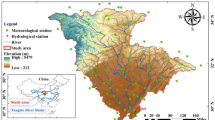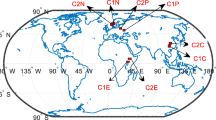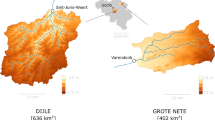Abstract
A growing number of investigations on uncertainty quantification for hydrological models have been widely reported in past years. However, limited studies are found on uncertainty assessment in simulating streamflow extremes so far. This article presents an intercomparison of uncertainty assessment of three different well-known hydrological models in simulating extreme streamflows using the approach of generalized likelihood uncertainty estimation (GLUE). Results indicate that: (1) The three modified hydrological models can reproduce daily streamflow series with acceptable accuracy. When the threshold value used to select behavioral parameter sets is 0.7, XAJ model generates the best GLUE estimates in simulating daily flows. However, the percentage of observations contained in the calculated 95 % confidence intervals (P-95CI) is low (<50 %) when simulating the high-flow index (Q10). (2) Decreasing average relative length (ARIL), P-95CI and increasing average asymmetry degree (AAD) are found, when the threshold value increases for both daily-flows and high-flows. However, there is a significant inconsistence between sensitivity of daily-flows and high-flows to various threshold values of the likelihood function. Uncertainty sources from parameter sets, model structure and inputs collectively accounts for above sensitivity. (3) The best hydrological model in simulating daily-flows is not identical under different threshold values. High P-95CIs of GLUE estimate for high-flows (Q10 and Q25) indicate that TOPMODEL generally performs best under different threshold values, while XAJ model produces the smallest ARIL under different threshold values. The results are expected to contribute toward knowledge improvement on uncertainty behaviors in simulating streamflow extremes by a variety of hydrological models.





Similar content being viewed by others
References
Abebe N, Ogden F, Pradhan N (2010) Sensitivity and uncertainty analysis of the conceptual HBV rainfall-runoff model: Implications for parameter estimation. Journal of Hydrology 389(3–4):301–310
Alvisi S, Franchini M (2011) Fuzzy neural networks for water level and discharge forecasting with uncertainty. Environmental Modelling and Software 26:523–537
Aronica G, Hankin B, Beven K (1998) Uncertainty and equifinality in calibrating distributed roughness coefficients in a flood propagation model with limited data. Advances in Water Resources 22(4):349–365
Arora VK (2002) The use of the aridity index to assess climate change effect on annual runoff. J Hydrol 265:164–177
Bahremand A, Smedt FD (2010) Predictive analysis and simulation uncertainty of a distributed hydrological model. Water Resour Manage 2010(24):2869–2880
Bates BC, Campbell EP (2001) A Markov chain Monte Carlo scheme for parameter estimation and inference in conceptual rainfall–runoff modeling. Water Resources Research 37:937–947
Benke KK, Lowell KE, Hamilton AJ (2007) Parameter uncertainty, sensitivity analysis and prediction error in a water-balance hydrological model. Mathematical and Computer Modeling 47(11–12):1134–1149
Bergström S (1976) Development and application of a conceptual runoff model for Scandinavian catchments. Ph.D. Thesis. SMHI Reports RHO No. 7, Norrköping, Sweden
Bergström S (1995) The HBV model. In: Singh VP (ed) Computer models of watershed hydrology. Water Resources Publications, Highlands Ranch, CO., pp 443–476
Beven K (2001) How far can we go in distributed hydrological modeling? Hydrology and Earth System Sciences 5(1):1–12
Beven KJ, Binley A (1992) The future of distributed models, model calibration and uncertainty prediction. Hydrological Processes 6:279–298
Beven KJ (1993) Prophecy, reality and uncertainty in distributed hydrological modelling. Advances in Water Resources 16:41–51
Beven KJ, Freer J (2001a) A dynamic TOPMODEL. Hydrological Processes 15:1993–2011
Beven KJ, Freer J (2001b) Equifinality, data assimilation, and uncertainty estimation in mechanistic modelling of complex environmental systems using the GLUE methodology. Journal of Hydrology 249:11–29
Beven KJ, Kirby MJ (1979) A physically based variable contributing area model of basin hydrology. Hydrological Science Bulletin 24:43–69
Beven KJ (1997) Distributed hydrological modelling: Applications of the TOPMODEL concept. John Wiley and Sons, Chichester
Blazkova S, Beven K (2004) Flood frequency estimation by continuous simulation of subcatchment rainfalls and discharges with the aim of improving dam safety assessment in a large basin in the Czech Republic. Journal of Hydrology 292:153–172
Carpenter TM, Georgakakos KP (2004) Impacts of parametric and radar rainfall uncertainty on the ensemble streamflow simulations of a distributed hydrological model. Journal of Hydrology 298:202–221
Cameron D, Beven KJ, Tawn J, Blazkova S, Naden P (1999) Flood frequency estimation by continuous simulation for a gauged upland catchment (with uncertainty). Journal of Hydrology 219:169–187
Chowdhury S, Sharma A (2007) Mitigating parameter bias in hydrological modelling due to uncertainty in covariates. Journal of Hydrology 340:197–204
Davies A (1997) Monthly snowmelt modelling for large-scale climate change studies using the degree day approach. Ecological Modelling 101(2–3):303–323
Diaz-Ramirez JN, McAnally WH, Martin JL (2012) Sensitivity of simulating hydrologic processes to gauge and radar rainfall data in subtropical coastal catchments. Water Resour Manage 26:3515–3538
Engeland K, Xu C-Y, Gottschalk L (2005) Assessing uncertainties in a conceptual water balance model using Bayesian methodology. Hydrological Sciences Journal 50(1):45–63
Freer J, Beven K, Ambroise B (1996) Bayesian estimation of uncertainty in runoff prediction and the value of data: An application of the GLUE approach. Water Resources Research 32(7):2161–2173
Georgakakos KP, Seo DJ, Gupta H et al (2004) Towards the characterization of streamflow simulation uncertainty through multimodel ensembles. Journal of Hydrology 298:222–241
Huang B, Jiang B (2002) AVTOP: A full integration of TOPMODEL into GIS. Environmental Modelling and Software 17(3):261–268
Iorgulescu I, Beven KJ, Musy A (2005) Data-based modelling of runoff and chemical tracer concentrations in the haute-menthue (Switzerland) research catchment. Hydrological Processes 19:2557–2574
Jiang T, Chen Y, Xu C, Chen X, Singh V (2007) Comparison of hydrological impacts of climate change simulated by six hydrological models in the Dongjiang Basin, South China. Journal of Hydrology 336(3–4):316–333
`Jin X, Xu C, Zhang Q, Singh VP (2010) Parameter and modeling uncertainty simulated by GLUE and a formal Bayesian method for a conceptual hydrological model. Journal of Hydrology 383:147–155
Ju Q, Yu Z, Hao Z, Ou G, Zhao J, Liu D (2009) Division-based rainfall-runoff simulations with BP neural networks and Xinanjiang model. Neurocomputing 72(13–15):2873–2883
Kavetski D, Franks S, Kuczera G (2002) Confronting input uncertainty in environmental modelling. In: Gupta HV, Sorooshian S, Rousseau AN, Turcotte R (eds) Calibration of watershed models. AGU Water Science and Applications Series, Duan, pp 49–68
Kavetski D, Kuczera G, Franks SW (2006a) Bayesian analysis of input uncertainty in hydrological modeling: 1. Theory Water Resources Research 42:W03407
Kavetski D, Kuczera G, Franks SW (2006b) Bayesian analysis of input uncertainty in hydrological modeling: 2. Application Water Resources Research 42(581):W03408
Kuczera G, Parent E (1998) Monte Carlo assessment of parameter uncertainty in conceptual catchment models: The metropolis algorithm. Journal of Hydrology 211:69–85
Lamb R, Beven KJ, Myrabø S (1998) Use of spatially distributed water table observations to constrain uncertainty in a rainfallrunoff model. Advances in Water Resources 22(4):305–317
Li L, Xia J, Xu C-Y, Singh VP (2010) Evaluation of the subjective factors of the GLUE method and comparison with the formal Bayesian method in uncertainty assessment of hydrological models. Journal of Hydrology 390:210–221
Li L, Xu C-Y, Xia J, Engeland K, Reggiani P (2011) Uncertainty estimates by Bayesian method with likelihood of AR (1) &normal model and AR (1) &multi-normal model in different time-scales hydrological models. Journal of Hydrology 406:54–65
Lin K, Guo S, Zhang W, Liu P (2007) A new baseflow separation method based on analytical solutions of the Horton infiltration capacity curve. Hydrological Processes 21(13):1719–1736
Marshall L, Nott D, Sharma A (2007) Towards dynamic catchment modelling: A Bayesian hierarchical modelling framework. Hydrological Processes 21:847–861
Nash JE, Sutcliffe JV (1970) River flow forecasting through conceptual models- Part 1-a. discussion of principles. Journal of Hydrology 10(3):282–290
Quinn P, Beven KJ, Lamb R (1995) The ln(α/tan β) index: how to calculate it and how to use it in the TOPMODEL framework. Hydrol Process 9:161–185
Rango A (1992) World-wide testing of the Snowmelt runoff model with applications for predicting the effects of climate change. Nordic Hydrology 23:155–172
Refsgaard JC, Storm B (1996) Construction calibration and validation of hydrological models. In: Abbott MB, Refsgaard JC (eds) Distributed hydrological modelling, water science and technology library, vol 22, Kluwer Academic Publishers. Dordrecht, The Netherlands, pp 41–54
Seibert J (2003) Reliability of model predictions outside calibration conditions. Nordic Hydrology 34:477–492
Stedinger JR, Vogel RM, Lee SU, Batchelder R (2008) Appraisal of the generalized likelihood uncertainty estimation (GLUE) method. Water Resources Research 44:W00B06. doi:10.1029/2008WR006822
Talebizadeh M, Morid S, Ayyoubzadeh SA et al (2010) Uncertainty analysis in sediment load modeling using ANN and SWAT model. Water Resour Manage 24:1747–1761
Thorndahl S, Beven KJ, Jensen JB (2008) Event based uncertainty assessment in urban drainage modeling, applying the GLUE methodology. Journal of Hydrology 357:421–437
Vazquez RF, Beven K, Feyen J (2009) GLUE based assessment on the overall predictions of a MIKE SHE application. Water Resour Manage 23:1325–1349
Wu S, Li J, Huang GH (2008) Characterization and evaluation of elevation data uncertainty in water resources modeling with GIS. Water Resour Manage 22:959–972
Xiong LH, Guo SL (2004) Effects of the catchment runoff coefficient on the performance of TOPMODEL in rainfall-runoff modeling. Hydrological Processes 18:1823–1836
Xiong LH, Wan M, Wei XJ (2009) Indices for assessing the prediction bounds of hydrological models and application by generalized likelihood uncertainty estimation. Hydrological Sciences Journal 54:852–871
Xu C-Y, Tunemar L, Chen YD, Singh VP (2006) Evaluation of seasonal and spatial variations of conceptual hydrological model sensitivity to precipitation data errors. Journal of Hydrology 324:80–93
Yang J, Reichert P, Abbaspour KC, Xia J, Yang H (2008) Comparing uncertainty analysis techniques for a SWAT application to the Chaohe Basin in China. Journal of Hydrology 358:1–23
Yang T, Shao Q, Hao Z, Chen X, Zhang Z, Xu C, Sun L (2010) Regional frequency analysis and spatio-temporal pattern characterization of rainfall extremes in Pearl River Basin, Southern China. Journal of Hydrology 380(3–4):386–405
Zhao RJ, Zhuang YL, Fang LR, Liu XR, Zhang QS (1980) The Xinanjiang model. Hydrological Forecasting Proceedings Oxford Symposium, 129. IAHS publication, pp. 351–356.
Acknowledgements
The work was jointly supported by grants from the National Natural Science Foundation of China (40901016, 40830639, 40830640), a grant from the State Key Laboratory of Hydrology-Water Resources and Hydraulic Engineering (2009586612, 2009585512), grants of Special Public Sector Research Program of Ministry of Water Resources (201201025), and the Fundamental Research Funds for the Central Universities (2010B00714).
Author information
Authors and Affiliations
Corresponding author
Rights and permissions
About this article
Cite this article
Chen, X., Yang, T., Wang, X. et al. Uncertainty Intercomparison of Different Hydrological Models in Simulating Extreme Flows. Water Resour Manage 27, 1393–1409 (2013). https://doi.org/10.1007/s11269-012-0244-5
Received:
Accepted:
Published:
Issue Date:
DOI: https://doi.org/10.1007/s11269-012-0244-5




